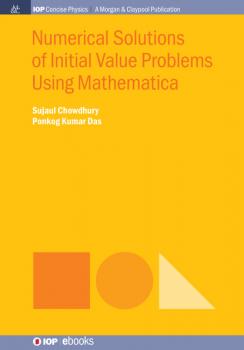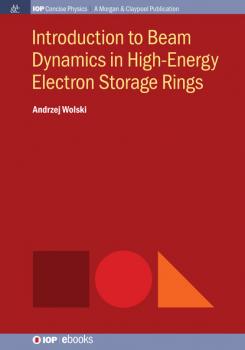IOP Concise Physics
Скачать книги из серии IOP Concise PhysicsNumerical Solutions of Initial Value Problems Using Mathematica
The book contains a detailed account of numerical solutions of differential equations of elementary problems of Physics using Euler and 2nd order Runge-Kutta methods and Mathematica 6.0. The problems are motion under constant force (free fall), motion under Hooke's law force (simple harmonic motion), motion under combination of Hooke's law force and a velocity dependent damping force (damped harmonic motion) and radioactive decay law. Also included are uses of Mathematica in dealing with complex numbers, in solving system of linear equations, in carrying out differentiation and integration, and in dealing with matrices.
Introduction to Beam Dynamics in High-Energy Electron Storage Rings
Electron storage rings play a crucial role in many areas of modern scientific research. In light sources, they provide intense beams of x-rays that can be used to understand the structure and behavior of materials at the atomic scale, with applications to medicine, the life sciences, condensed matter physics, engineering, and technology. In particle colliders, electron storage rings allow experiments that probe the laws of nature at the most fundamental level. Understanding and controlling the behavior of the beams of particles in storage rings is essential for the design, construction, and operation of light sources and colliders aimed at reaching increasingly demanding performance specifications. Introduction to Beam Dynamics in High-Energy Electron Storage Rings describes the physics of particle behavior in these machines. Starting with an outline of the history, uses, and structure of electron storage rings, the book develops the foundations of beam dynamics, covering particle motion in the components used to guide and focus the beams, the effects of synchrotron radiation, and the impact of interactions between the particles in the beams. The aim is to emphasize the physics behind key phenomena, keeping mathematical derivations to a minimum: numerous references are provided for those interested in learning more. The text includes discussion of issues relevant to machine design and operation and concludes with a brief discussion of some more advanced topics, relevant in some special situations, and a glimpse of current research aiming to develop the «ultimate» storage rings.
Relativistic Many-Body Theory and Statistical Mechanics
In 1941, E.C.G. Stueckelberg wrote a paper, based on ideas of V. Fock, that established the foundations of a theory that could covariantly describe the classical and quantum relativistic mechanics of a single particle. Horwitz and Piron extended the applicability of this theory in 1973 (to be called the SHP theory) to the many-body problem. It is the purpose of this book to explain this development and provide examples of its applications. We first review the basic ideas of the SHP theory, both classical and quantum, and develop the appropriate form of electromagnetism on this dynamics. After studying the two body problem classically and quantum mechanically, we formulate the N-body problem. We then develop the general quantum scattering theory for the N-body problem and prove a quantum mechanical relativistically covariant form of the Gell-Mann-Low theorem. The quantum theory of relativistic spin is then developed, including spin-statistics, providing the necessary apparatus for Clebsch-Gordan additivity, and we then discuss the phenomenon of entanglement at unequal times. In the second part, we develop relativistic statistical mechanics, including a mechanism for stability of the off-shell mass, and a high temperature phase transition to the mass shell. Finally, some applications are given, such as the explanation of the Lindneret alexperiment, the proposed experiment of Palacios et al which should demonstrate relativistic entanglement (at unequal times), the space-time lattice, low energy nuclear reactions and applications to black hole physics.
Electrodynamics
This book of problems and solutions is a natural continuation of Ilie and Schrecengost's first book Electromagnetism: Problems and Solutions. As with the first book, this book is written for junior or senior undergraduate students, and for graduate students who may have not studied electrodynamics yet and who may want to work on more problems and have an immediate feedback while studying. This book of problems and solutions is a companion for the student who would like to work independently on more electrodynamics problems in order to deepen their understanding and problem solving skills and perhaps prepare for graduate school. This book discusses main concepts and techniques related to Maxwell's equations, conservation laws, electromagnetic waves, potentials and fields, and radiation.
An Introduction to Planetary Nebulae
In this book we will look at what planetary nebulae are, where they come from and where they go. We will discuss what mechanisms cause these beautiful markers of stellar demise as well as what causes them to form their variety of shapes. How we measure various aspects of planetary nebulae such as what they are made of will also be explored. Though we will give some aspects of planetary nebulae mathematical treatment, the main points should be accessible to people with only a limited background in mathematics. A short glossary of some of the more arcane astronomical terms is at the end of the book to help in understanding. Included at the end of each chapter is an extensive bibliography to the peer reviewed research on these objects and I would encourage the reader interested in an even deeper understanding to read these articles.
An Introduction to Quantum Communication Networks
With the fast pace of developments in quantum technologies, it is more than ever necessary to make the new generation of students in science and engineering familiar with the key ideas behind such disruptive systems. This book intends to fill such a gap between experts and non-experts in the field by providing the reader with the basic tools needed to understand the latest developments in quantum communications and its future directions. This is not only to expand the audience knowledge but also to attract new talents to this flourishing field. To that end, the book as a whole does not delve into much detail and most often suffices to provide some insight into the problem in hand. The primary users of the book will then be students in science and engineering in their final year of undergraduate studies or early years of their post-graduate programmes.
A Concise Introduction to Quantum Mechanics
Assuming a background in basic classical physics, multivariable calculus, and differential equations, A Concise Introduction to Quantum Mechanics provides a self-contained presentation of the mathematics and physics of quantum mechanics. The relevant aspects of classical mechanics and electrodynamics are reviewed, and the basic concepts of wave-particle duality are developed as a logical outgrowth of experiments involving blackbody radiation, the photoelectric effect, and electron diffraction. The Copenhagen interpretation of the wave function and its relation to the particle probability density is presented in conjunction with Fourier analysis and its generalization to function spaces. These concepts are combined to analyze the system consisting of a particle confined to a box, developing the probabilistic interpretation of observations and their associated expectation values. The Schrödinger equation is then derived by using these results and demanding both Galilean invariance of the probability density and Newtonian energy-momentum relations. The general properties of the Schrödinger equation and its solutions are analyzed, and the theory of observables is developed along with the associated Heisenberg uncertainty principle. Basic applications of wave mechanics are made to free wave packet spreading, barrier penetration, the simple harmonic oscillator, the Hydrogen atom, and an electric charge in a uniform magnetic field. In addition, Dirac notation, elements of Hilbert space theory, operator techniques, and matrix algebra are presented and used to analyze coherent states, the linear potential, two state oscillations, and electron diffraction. Applications are made to photon and electron spin and the addition of angular momentum, and direct product multiparticle states are used to formulate both the Pauli exclusion principle and quantum decoherence. The book concludes with an introduction to the rotation group and the general properties of angular momentum.
How to Understand Quantum Mechanics
How to Understand Quantum Mechanics presents an accessible introduction to understanding quantum mechanics in a natural and intuitive way, which was advocated by Erwin Schroedinger and Albert Einstein. A theoretical physicist reveals dozens of easy tricks that avoid long calculations, makes complicated things simple, and bypasses the worthless anguish of famous scientists who died in angst. The author's approach is light-hearted, and the book is written to be read without equations, however all relevant equations still appear with explanations as to what they mean. The book entertainingly rejects quantum disinformation, the MKS unit system (obsolete), pompous non-explanations, pompous people, the hoax of the 'uncertainty principle' (it is just a math relation), and the accumulated junk-DNA that got into the quantum operating system by misreporting it. The order of presentation is new and also unique by warning about traps to be avoided, while separating topics such as quantum probability to let the Schroedinger equation be appreciated in the simplest way on its own terms. This is also the first book on quantum theory that is not based on arbitrary and confusing axioms or foundation principles. The author is so unprincipled he shows where obsolete principles duplicated basic math facts, became redundant, and sometimes were just pawns in academic turf wars. The book has many original topics not found elsewhere, and completely researched references to original historical sources and anecdotes concerting the unrecognized scientists who actually did discover things, did not all get Nobel prizes, and yet had interesting productive lives.
Of Clocks and Time
Of Clocks and Time takes readers on a five-stop journey through the physics and technology (and occasional bits of applications and history) of timekeeping. On the way, conceptual vistas and qualitative images abound, but since mathematics is spoken everywhere the book visits equations, quantitative relations, and rigorous definitions are offered as well. The expedition begins with a discussion of the rhythms produced by the daily and annual motion of sun, moon, planets, and stars. Centuries worth of observation and thinking culminate in Newton's penetrating theoretical insights since his notion of space and time are still influential today. During the following two legs of the trip, tools are being examined that allow us to measure hours and minutes and then, with ever growing precision, the tiniest fractions of a second. When the pace of travel approaches the ultimate speed limit, the speed of light, time and space exhibit strange and counter-intuitive traits. On this fourth stage of the journey, Einstein is the local tour guide whose special and general theories of relativity explain the behavior of clocks under these circumstances. Finally, the last part of the voyage reverses direction, moving ever deeper into the past to explore how we can tell the age of «things» – including that of the universe itself.
Ionization and Ion Transport
The purpose of this text is to introduce engineering and science students to the basic underlying physics and chemistry concepts that form the foundation of plasma science and engineering. It is an accessible primer directed primarily at those students who, like the general public, simply do not understand exactly what a plasma or gas discharge is nor do they even necessarily have the fundamental background in statistical thermodynamics, gas dynamics, fluid dynamics, or solid state physics to effectively understand many plasma and gas discharge principles. At the conclusion of this text, the reader should understand what an ion is, how they move, the equations we use to describe these basic concepts, and how they link to the aforementioned topics of plasmas and gas discharges. This book is focused on specific concepts that are important to non-equilibrium, low temperature gas discharges. These discharges find wide applicability today and are of significant interest to the scientific and engineering communities.









